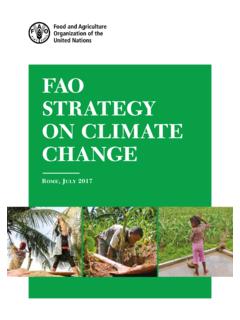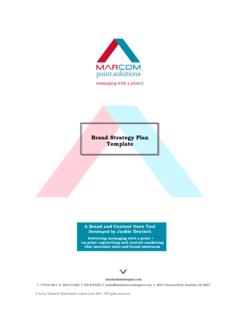Transcription of PARLIAMENT, THE COUNCIL, THE EUROPEAN …
1 EN EN EUROPEAN commission Brussels, COM(2018) 28 final COMMUNICATION FROM THE commission TO THE EUROPEAN PARLIAMENT, THE COUNCIL, THE EUROPEAN ECONOMIC AND SOCIAL COMMITTEE AND THE COMMITTEE OF THE REGIONS A EUROPEAN Strategy for Plastics in a Circular Economy {SWD(2018) 16 final} 1 1. INTRODUCTION Plastic is an important and ubiquitous material in our economy and daily lives. It has multiple functions that help tackle a number of the challenges facing our society. Light and innovative materials in cars or planes save fuel and cut CO2 emissions. High-performance insulation materials help us save on energy bills.
2 In packaging, plastics help ensure food safety and reduce food waste. Combined with 3D printing, bio-compatible plastic materials can save human lives by enabling medical innovation. However, too often the way plastics are currently produced, used and discarded fails to capture the economic benefits of a more 'circular' approach and harms the environment. There is an urgent need to tackle the environmental problems that today cast a long shadow over the production, use and consumption of plastics. The million tonnes of plastic litter that end up in the oceans every year are one of their most visible and alarming signs of these problems, causing growing public concern.
3 Rethinking and improving the functioning of such a complex value chain requires efforts and greater cooperation by all its key players, from plastics producers to recyclers, retailers and consumers. It also calls for innovation and a shared vision to drive investment in the right direction. The plastics industry is very important to the EUROPEAN economy, and increasing its sustainability can bring new opportunities for innovation, competitiveness and job creation, in line with the objectives pursued by the renewed EU Industrial Policy In December 2015, the commission adopted an EU Action Plan for a circular There, it identified plastics as a key priority and committed itself to prepare a strategy addressing the challenges posed by plastics throughout the value chain and taking into account their entire life-cycle.
4 In 2017, the commission confirmed it would focus on plastics production and use and work towards the goal of ensuring that all plastic packaging is recyclable by The EU is best placed to lead the transition to the plastics of the future. This strategy lays the foundations to a new plastics economy, where the design and production of plastics and plastic products fully respect reuse, repair and recycling needs and more sustainable materials are developed and promoted. This will deliver greater added value and prosperity in Europe and boost innovation.
5 It will curb plastic pollution and its adverse impact on our lives and the environment. By pursuing these aims, the strategy will also help achieve the priority set by this commission for an Energy Union with a modern, low-carbon, resource and energy-efficient economy and will make a tangible contribution to reaching the 2030 Sustainable Development Goals and the Paris Agreement. The strategy presents key commitments for action at EU level. Yet the private sector, together with national and regional authorities, cities and citizens, will also need to mobilise.
6 Similarly, international engagement will be necessary to drive change outside Europe s borders. With decisive and concerted efforts, Europe can turn challenges into opportunities and set the example for resolute action at global level. 1 COM(2017) 479. 2 COM(2015) 614. 3 commission Work Programme 2018 - COM(2017) 650. 2 2. PLASTICS TODAY: KEY CHALLENGES Over the past 50 years, the role and importance of plastics in our economy has consistently grown. Global production of plastics has increased twentyfold since the 1960s, reaching 322 million tonnes in 2015.
7 It is expected to double again over the next 20 years. In the EU, the plastics sector employs million people4 and generated a turnover of EUR 340 billion in 2015. Although plastics production in the EU has been stable in recent years, the EU s share of the global market is falling as production grows in other parts of the world. In the EU, the potential for recycling plastic waste remains largely unexploited. Reuse and recycling of end-of-life plastics is very low, particularly in comparison with other materials such as paper, glass or metals.
8 Around million tonnes of plastic waste are generated in Europe every Less than 30% of such waste is collected for recycling. Of this amount, a significant share leaves the EU6 to be treated in third countries, where different environmental standards may apply. At the same time, landfilling and incineration rates of plastic waste remain high 31 % and 39 %, respectively and while landfill has decreased over the past decade, incineration has grown. According to estimates, 95 % of the value of plastic packaging material, between EUR 70 and 105 billion annually, is lost to the economy after a very short first-use Demand for recycled plastics today accounts for only around 6 % of plastics demand in Europe.
9 In recent years, the EU plastic recycling sector has suffered from low commodity prices and uncertainties about market outlets. Investments in new plastic recycling capacity have been held back by the sector s prospects of low profitability. 4 This includes raw material producers and product manufacturers. 5 Source: Plastics Europe. 6 Source: Eurostat. 7 Ellen MacArthur Foundation, The new plastics economy, 2016 ( ). 3 It was estimated that plastics production and the incineration of plastic waste give rise globally to approximately 400 million tonnes of CO2 a Using more recycled plastics can reduce dependence on the extraction of fossil fuels for plastics production and curb CO2 According to estimates,10 the potential annual energy savings that could be achieved from recycling all global plastic waste is equivalent to billion barrels of oil per year.
10 Alternative types of feedstock ( bio-based plastics or plastics produced from carbon dioxide or methane), offering the same functionalities of traditional plastics with potentially lower environmental impacts, are also being developed, but at the moment represent a very small share of the market. Increasing the uptake of alternatives that according to solid evidence are more sustainable can also help decrease our dependency on fossil fuels. Very large quantities of plastic waste leak into the environment from sources both on land and at sea, generating significant economic and environmental damage.















